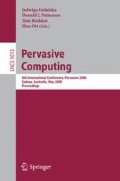Abstract
People-centric sensor-based applications targeting mobile device users offer enormous potential. However, learning inference models in this setting is hampered by the lack of labeled training data and appropriate feature inputs. Data features that lead to better classification models are not available at all devices due to device heterogeneity. Even for devices that provide superior data features, models require sufficient training data, perhaps manually labeled by users, before they work well. We propose opportunistic feature vector merging, and the social-network-driven sharing of training data and models between users. Model and training data sharing within social circles combine to reduce the user effort and time involved in collecting training data to attain the maximum classification accuracy possible for a given model, while feature vector merging can enable a higher maximum classification accuracy by enabling better performing models even for more resource-constrained devices. We evaluate our proposed techniques with a significant places classifier that infers and tags locations of importance to a user based on data gathered from cell phones.
Access this chapter
Tax calculation will be finalised at checkout
Purchases are for personal use only
Preview
Unable to display preview. Download preview PDF.
References
Acuna, E., Rodriguez, C.: The treatment of missing values and its effect in the classifier accuracy. In: Classification, Clustering and Data Mining Applications, pp. 639–648 (2004)
Ashbrook, D., Starner, T.: Using gps to learn significant locations and predict movement across multiple users. Personal and Ubiquitous Computing 7(5), 275–286 (2003)
Bishop, C.M.: Pattern Recognition and Machine Learning (Information Science and Statistics). Springer, Heidelberg (2006)
Choudhury, T., Pentland, A.: Sensing and modeling human networks using the sociometer. In: ISWC 2003: Proc. of the 7th IEEE Int’l Symp. on Wearable Computersp, Washington, DC, USA, p. 216 (2003)
Cox, L.P., Dalton, A., Marupadi, V.: Smokescreen: flexible privacy controls for presence-sharing. In: MobiSys 2007: Proc. of the 5th int’l conf. on Mobile systems, applications and services, pp. 233–245. ACM, New York (2007)
Eagle, N., Pentland, A.S.: Reality mining: sensing complex social systems. Personal Ubiquitous Comput. 10(4), 255–268 (2006)
Goldberg, D., Nichols, D., Oki, B.M., Terry, D.: Using collaborative filtering to weave an information tapestry. Commun. ACM 35(12), 61–70 (1992)
Gruteser, M., Grunwald, D.: Enhancing location privacy in wireless lan through disposable interface identifiers: a quantitative analysis. In: WMASH 2003: Proc. of the 1st ACM Int’l workshop on Wireless mobile applications and services on WLAN hotspots, New York, NY, USA, pp. 46–55 (2003)
Hightower, J., Consolvo, S., LaMarca, A., Smith, I., Hughes, J.: Learning and recognizing the places we go. In: Beigl, M., Intille, S.S., Rekimoto, J., Tokuda, H. (eds.) UbiComp 2005. LNCS, vol. 3660, pp. 159–176. Springer, Heidelberg (2005)
Hofmann, T., Basilico, J.: Collaborative machine learning. In: From Integrated Publication and Information Systems to Virtual Information and Knowledge Environments, pp. 173–182 (2005)
Kang, J.H., Welbourne, W., Stewart, B., Borriello, G.: Extracting places from traces of locations. SIGMOBILE Mob. Comput. Commun. Rev. 9(3), 58–68 (2005)
Krumm, J., Hinckley, K.: The nearme wireless proximity server. In: Davies, N., Mynatt, E.D., Siio, I. (eds.) UbiComp 2004. LNCS, vol. 3205, pp. 283–300. Springer, Heidelberg (2004)
Liao, L., Fox, D., Kautz, H.: Location-based activity recognition. In: Advances in Neural Information Processing Systems 18, pp. 787–794. MIT Press, Cambridge (2006)
Luo, H., Luo, J., Liu, Y., Das, S.K.: Adaptive Data Fusion for Energy Efficient Routing in Wireless Sensor Networks. IEEE Trans. on Comp. 55(10), 1286–1299 (2006)
Marmasse, N., Schmandt, C., Spectre, D.: Watchme: Communication and awareness between members of a closely-knit group. In: Davies, N., Mynatt, E.D., Siio, I. (eds.) UbiComp 2004. LNCS, vol. 3205, pp. 214–231. Springer, Heidelberg (2004)
Miluzzo, E., Lane, N.D., Eisenman, S.B., Campbell, A.T.: Cenceme - injecting sensing presence into social networking applications. In: Kortuem, G., Finney, J., Lea, R., Sundramoorthy, V. (eds.) EuroSSC 2007. LNCS, vol. 4793, pp. 1–28. Springer, Heidelberg (2007)
Patterson, D.J., Liao, L., Fox, D., Kautz, H.A.: Inferring high-level behavior from low-level sensors. In: Dey, A.K., Schmidt, A., McCarthy, J.F. (eds.) UbiComp 2003. LNCS, vol. 2864, pp. 73–89. Springer, Heidelberg (2003)
Patterson, D.J., Liao, L., Gajos, K., Collier, M., Livic, N., Olson, K., Wang, S., Fox, D., Kautz, H.A.: Opportunity knocks: A system to provide cognitive assistance with transportation services. In: Davies, N., Mynatt, E.D., Siio, I. (eds.) UbiComp 2004. LNCS, vol. 3205, pp. 433–450. Springer, Heidelberg (2004)
Shardanand, U., Maes, P.: Social information filtering: algorithms for automating word of mouth. In: CHI 1995: Proc. of the SIGCHI conf. on Human factors in computing systems, New York, NY, USA, pp. 210–217 (1995)
Witten, I.H., Frank, E.: Data mining: practical machine learning tools and techniques with Java implementations. Morgan Kaufmann Publishers Inc., San Francisco (2000)
Zhou, C., Frankowski, D., Ludford, P., Shekhar, S., Terveen, L.: Discovering personally meaningful places: An interactive clustering approach. ACM Trans. Inf. Syst. 25(3), 12 (2007)
Zhu, X.: Semi-Supervised Learning Literature Survey. Tech. Report UW-Madison 1530 (2005)
Author information
Authors and Affiliations
Editor information
Rights and permissions
Copyright information
© 2008 Springer-Verlag Berlin Heidelberg
About this paper
Cite this paper
Lane, N.D., Lu, H., Eisenman, S.B., Campbell, A.T. (2008). Cooperative Techniques Supporting Sensor-Based People-Centric Inferencing. In: Indulska, J., Patterson, D.J., Rodden, T., Ott, M. (eds) Pervasive Computing. Pervasive 2008. Lecture Notes in Computer Science, vol 5013. Springer, Berlin, Heidelberg. https://doi.org/10.1007/978-3-540-79576-6_5
Download citation
DOI: https://doi.org/10.1007/978-3-540-79576-6_5
Publisher Name: Springer, Berlin, Heidelberg
Print ISBN: 978-3-540-79575-9
Online ISBN: 978-3-540-79576-6
eBook Packages: Computer ScienceComputer Science (R0)

